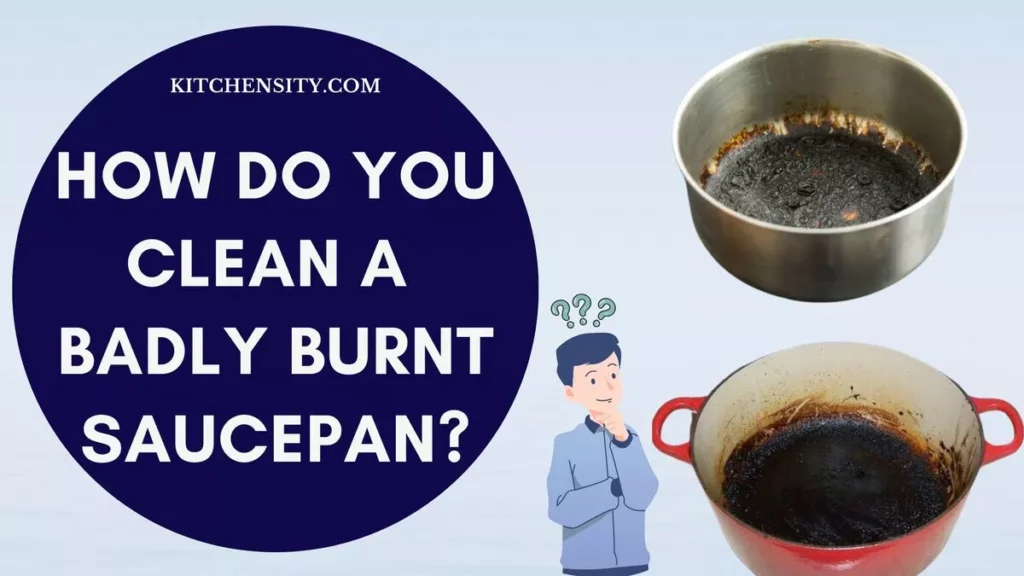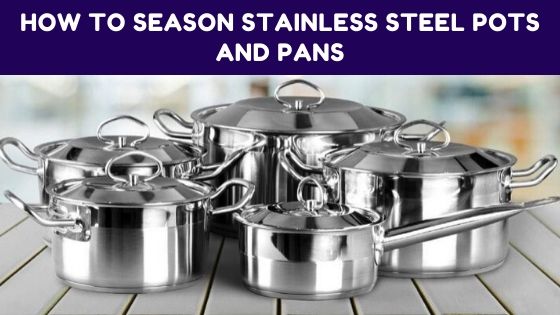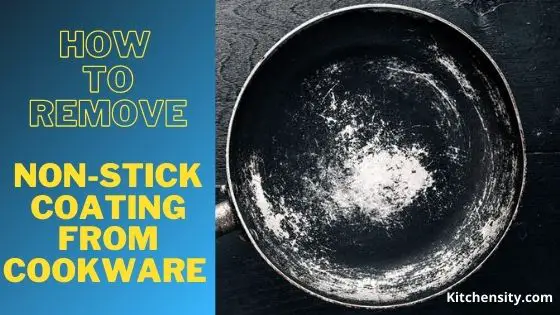Dealing with a badly burnt saucepan can be a frustrating and challenging task, but fear not! With the right techniques and a little know-how, you can effectively clean and restore your saucepan to its former shine.
To clean a badly burnt saucepan, start by soaking it in a mixture of warm water and dish soap. After that, take a sponge and gently scrub with baking soda or a vinegar solution to lift stubborn residues. Rinse thoroughly and dry properly to restore your saucepan’s shine and functionality.

Read below for a step-by-step guide.
Table of Contents
- 1 Gathering The Necessary Supplies.
- 2 Steps To Clean A Badly Burnt Saucepan.
- 3 How To Polish The Saucepan To Bring Its Shine?
- 4 How To Avoid The Saucepan From Getting Burnt?
- 5 Final Verdict.
- 6 FAQs (Frequently Asked Questions).
- 6.1 What’s The Best Thing To Clean A Burnt Saucepan?
- 6.2 Can You Clean A Burnt Pan With Salt?
- 6.3 Can I Use Steel Wool To Clean A Burnt Saucepan?
- 6.4 Is It Safe To Use Chemical Cleaners On My Saucepan?
- 6.5 Can I Clean A Burnt Saucepan With Just Hot Water?
- 6.6 How Often Should I Clean My Saucepans To Prevent Burnt-On Residue?
Gathering The Necessary Supplies.
To clean a badly burnt saucepan effectively, you’ll need specific supplies, including:
- Dish soap.
- Baking soda.
- Vinegar.
- Lemon (for stubborn stains).
- Baking powder.
- Soft cloth or sponge.
- Boiling water.
Also Read – How To Clean Burnt Glass Pans?
Steps To Clean A Badly Burnt Saucepan.
Here, you will learn six effective ways to clean a badly burnt saucepan, using methods like soaking, scrubbing with baking soda or vinegar, and more to restore its pristine condition.
Step 1 – Soaking The Saucepan.
Before diving into the cleaning process, it’s essential to soak the burnt saucepan. This will help loosen the stubborn burnt-on residue, making it easier to remove later.
To begin, fill the saucepan with hot water. Ensure the water level is enough to cover all the burnt areas. Next, add a few drops of dish soap to the water and give it a gentle stir. The dish soap’s degreasing properties will aid in breaking down the burnt particles and grease stuck to the pan’s surface. Now, let the saucepan sit and soak for at least 30 minutes. During this time, the hot water and soap will work their magic, loosening the burnt residue and making it less adherent to the pan.
Patience is key during this soaking phase, as it sets the stage for successful cleaning ahead. So, let’s give the pan some time to soak, and we’ll move on to the next step once the soaking time is up!
Also Read – How To Get Burnt Sugar Off A Pan?
Step 2 – Use Baking Soda And Vinegar For Cleaning.
First, drain the water from the saucepan after soaking and sprinkle a generous amount of baking soda directly onto the burnt areas of the pan. Baking soda is a mild abrasive that helps to lift and loosen stubborn burnt particles without damaging the pan’s surface.
Next, pour vinegar over the baking soda. You’ll notice a fizzing reaction as the vinegar comes into contact with the baking soda. This chemical reaction helps to break down the burnt residues and grease, making them easier to remove. Allow the baking soda and vinegar mixture to sit on the burnt areas for a few minutes.
During this time, the solution will continue to work its magic, softening the burnt-on residues. After some time, take a non-abrasive scrubber or a soft sponge and gently scrub the saucepan’s surface. Thanks to the cleaning power of baking soda and vinegar, you’ll notice that the burnt residues are now much easier to lift and remove. Continue scrubbing until you’ve removed as many burnt-on residues as possible. You can also squeeze some lemon to scrub the stubborn stains.
Once you’ve thoroughly cleaned the saucepan, rinse it with water to remove any remaining baking soda and vinegar. Now, your saucepan should be looking much cleaner and ready for the next step in the cleaning process.
Also Read – How To Clean Burnt Hard Anodized Cookware?
You can check out this video:
How To Polish The Saucepan To Bring Its Shine?
Now that you’ve successfully removed the burnt-on stains from your saucepan, it’s time to give it a final touch to bring back its shine and luster. Polishing the saucepan is the last step in the cleaning process, and it will leave your cookware looking brand new and ready for your next culinary masterpiece.
Here’s how to polish your saucepan:
- Before polishing, rinse the saucepan thoroughly with clean water to remove any remaining traces of the cleaning agents you used earlier.
- After that, use a soft and clean cloth to dry the saucepan completely. Make sure there’s no moisture left on the surface, as this can lead to water spots and streaks during the polishing process.
- Depending on the material of your saucepan, select an appropriate polish to restore its shine. For stainless steel saucepans, a stainless steel cleaner will work wonders. For non-stick surfaces, use a non-stick cookware polish. Copper saucepans may require a copper polish.
- Apply a small amount of the polish to a soft cloth and, then rub it onto the pan’s surface in circular motions.
- After applying the polish, use a clean part of the cloth to buff the saucepan’s surface gently. Buffing will help spread the polish evenly and give the saucepan a beautiful shine.
- Don’t forget to polish the saucepan’s handles and lids as well. These areas can accumulate stains and tarnish, so giving them a proper polish will ensure uniformity.
- Check for any excess polish on the saucepan and remove it with a clean cloth.
Also Read – How To Clean Burnt Calphalon Pans?
How To Avoid The Saucepan From Getting Burnt?
To avoid burning your saucepan, follow these tips:
- Use low to medium heat for most cooking. High heat can cause sauces to burn quickly.
- Regular stirring prevents the sauce from sticking to the pan and burning.
- Keep an eye on the cooking time. Longer cooking times increase the risk of burning. Set a timer to remind you to check and stir the sauce regularly.
- If the sauce is getting too thick or starting to burn, add a splash of liquid (water, broth, wine) and stir.
- If you notice the sauce starting to burn, immediately reduce the heat and stir to prevent further burning.
- Burnt bits on the bottom of the pan can cause the sauce to burn. Clean the pan thoroughly after each use.
- A simmer plate can help distribute heat evenly and prevent sauces from burning.
- A pan with a thick, heavy bottom distributes heat more evenly and reduces the risk of burning.
Also Read – How To Clean Oxidized Aluminum Pans?
Final Verdict.
Cleaning a badly burnt saucepan may initially seem like a daunting task, but with the right approach and a little patience, it’s entirely possible to restore your beloved cookware to its former glory. By following the outlined steps, from soaking and using natural cleaners to gentle scrubbing, you can effectively remove stubborn burnt-on stains and bring back the shine to your saucepan.
Remember, prevention is key to avoiding burnt incidents in the future. Regulating heat levels, staying attentive while cooking, and using non-abrasive materials will help protect your saucepan from burning and maintain its longevity.
Also Read – How To Get Melted Plastic Off Pans?
FAQs (Frequently Asked Questions).
-
What’s The Best Thing To Clean A Burnt Saucepan?
The best thing to clean a burnt saucepan is a mixture of baking soda and white vinegar.
-
Can You Clean A Burnt Pan With Salt?
Yes, you can clean a burnt pan with salt by sprinkling it on the burnt areas and scrubbing gently with water.
-
Can I Use Steel Wool To Clean A Burnt Saucepan?
It is best to avoid using steel wool as it can scratch the surface of the saucepan. Opt for non-abrasive scrubbers or soft sponges instead.
-
Is It Safe To Use Chemical Cleaners On My Saucepan?
While many chemical cleaners are safe for cookware, using natural cleaners like baking soda and vinegar can be equally effective and more environmentally friendly.
-
Can I Clean A Burnt Saucepan With Just Hot Water?
Hot water alone might not be sufficient to clean a badly burnt saucepan. It’s best to use it as a soaking agent in combination with other cleaning methods.
-
How Often Should I Clean My Saucepans To Prevent Burnt-On Residue?
It’s a good practice to clean your saucepans after each use to prevent burnt-on residue from building up over time.
Katrina Smith is a seasoned expert with over 25 years of experience in all things related to cooking and the kitchen. As an avid cook and kitchen enthusiast, she is passionate about sharing her knowledge and expertise on cookware, kitchen appliances, kitchen tips, and kitchen staples.
Through her articles and reviews, Katrina aims to inspire and help others improve their cooking skills, experiment with different ingredients, and invest in quality cookware and appliances.

![How To Season And Clean Cast Iron Cookware? [4 Effective Ways] 3 How To Season And Clean Cast Iron Cookware](https://www.kitchensity.com/wp-content/uploads/2020/06/How-To-Season-And-Clean-Cast-Iron-Cookware.jpg)

![Stainless Steel Vs Nonstick Vs Ceramic Cookware Set [An Ultimate Guide 2023] 5 Stainless Steel vs Nonstick vs Ceramic Cookware Set](https://www.kitchensity.com/wp-content/uploads/2019/09/Stainless-Steel-vs-Ceramic-vs-Nonstick-Cookware-Sets-e1621083482728.jpg)

![What Pans Can You Use Cooking Spray On? [Ultimate Guide] 7 Types of pans with which cooking spray can be used](https://www.kitchensity.com/wp-content/uploads/2023/02/What-Pans-Can-You-Use-Cooking-Spray-On.jpg)
